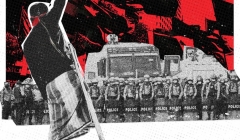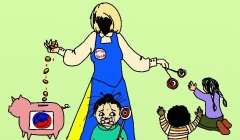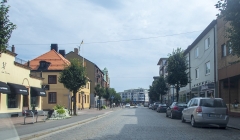In 2020, the artist Munish Wadhia took up an artistic residency in a space with deep roots in colonialism: The Match Museum in Jönköping. By the end, it was fraught by deep distrust, positions of power laid bare and a retreading of the very structures the art was meant to question. In an article for Kultwatch, Munish Wadhia discusses his experience with the Match Museum residency and connects it to a sweeping historical and theoretical context where the construction of whiteness still permeates the institutional framework art functions within.
In 1997, at art school in London, the experience of disorientation at being immersed in an institutionalised white space framed my practice and education. This triggered a sudden reaction to an everyday object, the illustration on a matchbox label, with the text “England’s Glory” and an image of a Victorian battleship. The banality of the matchbox label effortlessly carrying imperial nostalgia was disturbing. For me this minute everyday object echoed the eurocentric perspective of the art institution.
During my artist residency at the Match Museum (Tändsticksmuseet) in Jönköping in 2020, I had a similar alienating experience on encountering a white space. In this context, my artistic enquiry was treated as belonging to a specific interest; my questions were of a particular nature outside their universal concerns. Nirmal Puwar uses the expression “Space Invaders” to describe what happens when women and ethnically marked bodies enter spaces that are not designed for them:
‘space invaders’ endure a burden of doubt, a burden of representation, infantilisation and super-surveillance.1
In this report, I share my experience of becoming the “space invader”, occupying a space that was not designed or intended for my arrival.
Background
It was in 2010 that my attention was drawn to matchbox labels again by a copy of the artist Ravi Varma’s illustration of the Hindu goddess Kali that had the words “Made in Sweden” in bold on a matchbox label. I had been living in Sweden for a few years and as part of my practice I was interested in tracing the historical roots of the prints of Hindu gods that hung on the walls of my childhood home in Leicester, England.
Hindu mythological prints have been one of many markers of tradition and identity for the diaspora community I belong to. Through a western gaze, these sacred images are essentialised and appropriated onto kitsch decorative objects. However, their aesthetic form has arrived through a complex history of colonial resistance, political struggle, and religious liberation. With the advances of print technology, a hybrid of influences from 19th century European painting and regional painterly traditions allow the Hindu gods to take shape and reach the masses.
The artist Ravi Varma is renowned for his paintings of mythological tales with realistic depictions of Hindu gods. His use of the academic style, championed by the colonisers, performs what Christopher Pinney calls a “Sly Civility”2 appeasing the civilising mission at the same time as subverting the pictorial narrative into an anti-colonial resistance. In my artistic practice I use references embedded in these prints strategically to speak about my personal and private history and navigate the westernised gaze by dislocating the pictorial and symbolic elements. My work appears as landscape paintings and large-scale painterly installations bringing the exotic foreign and familiar into a shared proximity where the margins of difference become blurred.

”Made in Sweden” an artist residency at the Match Museum in Jönköping
When I learned about the residency programme, “Made in Sweden” at the Match Museum in Jönköping I immediately enquired about the possibility of a residency and followed up with a proposal focusing on the historical overlap between the Swedish match industry and colonial India. I was interested in tracing how their paths cross to bring the Hindu mythological prints to Sweden more than a century ago and how ideas remain exoticised and foreign when they have occupied a space for so long. I was offered the residency from January 2020. The Museum defined the aims of the partnership as using artistic research as a process to raise questions and bring new understandings to the collection that would result in an art exhibition in September 2020.
During my initial tour of the museum, I encountered a display of illustrations of match labels in cabinets, complemented by advertising placards, where images of flora and animals blended seamlessly with racist tropes and colonial fantasies. Amongst these prints were the Hindu mythological prints I had come to investigate. In this environment where racism was perpetuated, images close to my ancestral identity were framed as exotic.
I felt further out of place at the presentation of a large, framed certificate from the World Exposition of 1893 in Chicago,3 with a title celebrating 400 years of the arrival of Christopher Columbus to the Americas, to indicate the quality of the matches. Through the absence of any criticality, the museum forecloses accountability for the match industry’s part in shaping an idea of European superiority and the justification of colonialism.
The entry to the museum is adorned with Solstickan merchandise, that symbolises the happy national narrative of a benevolent industry bringing the worker out of poverty with a spotlight on child welfare. The racist entanglements with this happy narrative were highlighted during my research when finding a propaganda film by the match company named “Indianer och blekansikten”4 persuading people to buy the Solstickan brand, in order to fund summer camps for disadvantaged city children, to give them the opportunity to go to the countryside and play ‘Indianer’. From statistics I encountered during my research5 I found out that child labour was still part of the match industry in India after it had been banned in Sweden. The benevolence given to some children is contrasted by the exploitation of others. The museum takes pride in presenting global international success yet fails to present or examine the political and industrial practices that brought these profits and wealth from European colonies. It justifies this by exclaiming their focus is on the local.

In contrast to what was on display in the museum, hidden in the archive multiple and diverse narratives were present. I discovered a large number of photographs from factories throughout the world. In a photo album made as a 50th birthday gift to Ivar Kreuger, founder of Swedish Match6 by his staff in India in the 1930’s, an image showed a shop front with “SWEDISH MATCHES” written in English and Gujarati, my home language. Within the museum display these photographs and stories of people of diverse origins could not find space, yet racialized stereotypes of them were a natural fit.
Dan Hicks, a curator and author of “The Brutish Museums: The Benin Bronzes, Colonial Violence and Cultural Restitution”7 suggests the curatorial tendency of many museums is to racialize its audience as white:
“the anthro museum not only enacts the so-called “primitive” as other; it also racialises the visitor and curator as white.”8
Unlike the anthropological museums he targets in his book, the Match Museum is not built through the brutal theft of objects. However, the same logic applies here, too. The displays of illustrations on match labels and advertising plaques with orientalised and exoticised depictions that present the Other as ‘primitive’ were produced and printed by the match company. As with the prints of the world fairs certificates their is an absence of critique and when viewed side by side these prints though starkly different in size and authority speak of a colonial complicity. A mind-set that naturally erases thousands of stories memorialised through photographic documentation in the archive.
Smoke in the eye
“While all can, in theory, enter, it is certain types of bodies that are tacitly designated as being the ‘natural’ occupants of specific positions. Some bodies are deemed as having the right to belong, while others are marked out as trespassers, who are, in accordance with how both spaces and bodies are imagined (politically, historically and conceptually), circumscribed as being ‘out of place’.“9
During the residency I raised questions in response to artefacts on display that symbolised a colonial gaze and orientation. I wanted an explanation of the specific artefacts with the aim of productive discussion about the industry and its relationship to imperialism and colonialism. However, this triggered an unexpected fragility and defensiveness that resulted in some small tensions. But I remained empowered by the opportunity of a platform to speak about these issues through the materiality and poetics of art.

In my studio, I was experimenting with the specific red color Faluröd that is associated with Swedish romantic cottages and Sindoor pigment commonly used in Hindu rituals but also in constructing national identities and tradition. Significant is how the pigments share the same hue, and in the exhibition I attempted to set them into a relation of oneness, diffusing into a singular colour. In doing so, I was aiming to dislocate their essentialising difference and demythologise the psychological distance between the foreign and the familiar into a shared proximity. This formed part of a sound, film and painting installation making up the exhibition Smoke in the Eye: Rupture in the Colonial Archive.
In June, the museum informed me that they planned to commission a large billboard poster with international matchbox labels to be placed in front of the museum building to market my exhibition. I was invited to offer suggestions of my preferred labels. I requested they use an image that related to my work and practice. Without further consultation the museum proceeded with their idea informing me that they had chosen Indian match labels and refused to replace them with an image of my work. In response, I demanded my name not be associated with the poster. This took place even though I had been interviewed twice at the beginning of the residency by the municipality communications department and a freelance journalist to produce a text reflecting on my practice and initial research. I informed them of the contradictions I saw in the archive, how people of colour were represented through an exotic gaze and the hundreds of photographs of factories and workers that had not been included in the Museum narrative. I also emphasised that I did not want my biography to be the focus of any marketing, conscious of the risk of my ethnicity being used as a checkbox for diversity work and to formulate difference.
I arrived at the museum for a two-week install process in September with a feeling of empowerment and excitement over bringing the installation to life following eight months of work. A short walk into Jönköping centre later that evening robbed me of any power I had felt as I became emotionally paralysed by large, illuminated posters with the title “Ett kolonialt perspektiv, konstutställning av Munish Wadhia”10 and an image of a hand in a white glove inspecting Indian matchboxes.

I demanded the posters to be taken down and initially they said it was not possible. Then, following consultation with the art workers organisation Konstnärernas Riksorganisation, who recommended I ask them to consult their legal team, they were reluctantly taken down, seven days after my request.
The white glove covering the hand in the posters behaves as a metaphor of the racialised nature of this action where whiteness speaks for and violates the brown body, an act of ventriloquism. This speech act silenced my voice, and later during a three-hour meeting, where I reluctantly described how racism impacts the brown body, revealing my trauma, they pleaded innocence and denial. After these incidents I asked that they publicly correct and compensate me for the misguided marketing and the misuse of my name. I also asked for a plan of action from the municipality and museum to start a working process on decolonising the museum display. The aim would be to recognise that there is a racist structure that the industry grew from and a racist inheritance that the museology is shaped around and, in recognising this, there is a direction of change to move towards that is empowering for all people.
The structure of power in this skewed partnership was made evident by the director of the culture department of the city’s municipality (Jönköpings Kulturförvaltning) who, rather than choosing dialogue to repair trust instead denied any responsibility and requested his lawyer to send me a short letter stating there were no legal grounds for my demands. This abruptly ended all communication even while my show was running. The letter was beyond reason an aggressive act of power and denial of responsibility. I had clearly become the “space invader”, and to complain and demand actions to address the issues that had surfaced through my residency was seen as a threat and an unwanted invasion of their occupancy of the position of authority.

In trying to come to a closure with this experience a possible strategy of moving on is by drawing upon Kehinde Andrews notion of whiteness as psychosis, with the important understanding that structures of violence cannot be broken if the violence cannot be seen.
Slavery, genocide, and colonialism are foundation stones of Western modernity, and through neo-colonial economic policies and exploitation of developing world labor is the system maintained. The system is held together by ignoring the chasm between myth and reality, which is why Whiteness manifests itself as a psychosis…
…if we see Whiteness as a psychosis, then we understand that it is hallmarked by irrationality and a distinct inability to see reality in any other way than the distorted view it creates.11
In regards to the artistic residency at the Match Museum this distorted view preserves a curated national narrative based on racialising the visitor as white. This simultaneously creates and denies the experience of the space invader, and leaves no room for raising questions or bringing new understandings that can stimulate a movement towards change.
Top image: Munish Wadhia, 2020. Installation image from the exhibition Smoke in the Eye: Rupture in the Colonial Archive, Match Museum, Jönköping. Photo: Linda Söndergaard.
Footnotes
1. Puwar, Nirmal. Space invaders: race, gender and bodies out of place. Oxford New York: Berg, 2004. p. 11.
2. Pinney, Christopher, Photos of the Gods: The Printed Image and Political struggle in India. London: Reaktion Books, 2004.
3. The early World Fairs, through exhibits such as human zoos were an integral part of celebrating European civilization as superior in opposition to the primitive Other. These tools in constructing the myth of the exotic foreign other were the justification for colonialism.
4. Indianer och blekansikten [Indians and pale faces] (1945), Indianer is the derogatory term in Swedish for indigineous people, https://www.filmarkivet.se/movies/indianer-och-blekansikten.
5. Svenska Tändsticksaktiebolaget, The Swedish match company: General staff rules for India. [Pärm.] [Illustr.], Bombay, 1929.
6. Between 1917-1932 Ivar Kreuger formed Svenska Tändstickor AB taking control of all Swedish match factories and expanding rapidly into a multinational company by providing loans to governments in exchange for match monopolies. He was primarily funded through US investors and the US stock market crash of 1929 revealed how he had grown the company through fraudulent accounting methods eventually leading to his suicide in 1932.
7. Hicks, Dan, The Brutish Museums: The Benin Bronzes, Colonial Violence and Cultural Restitution, Pluto Press, London 2020.
8. Private email correspondence with Dan Hicks.
9. Puwar, Nirmal, Space invaders: race, gender and bodies out of place. Oxford New York: Berg, 2004. p.8.
10. English translation, “A colonial perspective, art exhibition by Munish Wadhia”.
11. K. Andrews, The Psychosis of Whiteness: the celluloid hallucinations of Amazing Graze and Belle. Journal of Black Studies 2016.





